
views
Planning the Electric Fence
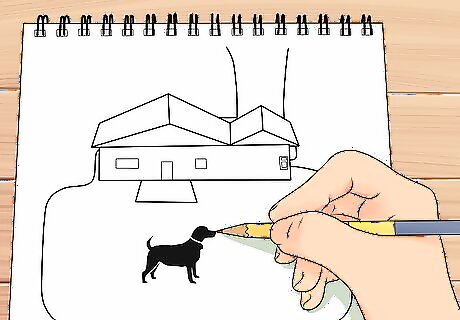
Plan the exact confines of the area you wish to contain your dog in. This will allow you to buy the exact correct amount of wire. Plant marker flags around the yard to mark where you will eventually lay the wire underground. Underground dog fences are effective because they allow you to plan around oddly shaped yard features, whereas above-ground fences must usually be built in a straight line. Underground dog fences are mostly used to keep a dog from running away, but they can also be used to prevent your dog from entering areas you don't want it to. For example, you can lay wire around a garden, or around a hot tub.
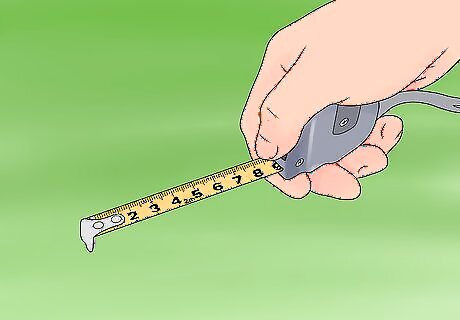
Measure the length and width of the area you want to contain the dog in. Using a large tape measure, take note of the size of the area that you plan to install the dog fence in. You don't need to take measurements of the house, as the dog won't be able to break through your home's walls, just know how long the wire should be to fully surround the area you want to contain your dog in. This ensures that when you go to buy the wire, you don't spend any more than you need to and can get a precise length.
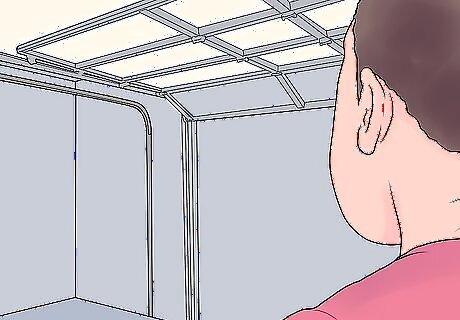
Find a good place to keep the transmitter inside, and make sure to ground it. The transmitter should not be kept near a breaker, appliances, or other sources of possible electrical interference. Keeping it in a garage is usually a safe bet, but be sure to keep it away from anything that could interrupt the system. Grounding the transmitter can prevent major damage by separating the system from other sources of electrical interference, and should be done according to the user manual that comes with your transmitter. Use a surge protector to make sure that the fence stays on during electrical interference. If the power goes out, make sure to bring your dog back inside until the underground fence is reactivated.
Beginning Installation

Lay the wire above ground along the marker flags you placed earlier. Lay the wire as straight as you can across the boundaries of the confined area, and make sure that you have enough wire to make it back to the starting point. Be sure to round off any 90 degree angles, as some transmitters won't recognize the sharp turn correctly. Avoid twisting the wire as best as you can, as this can cause issues with the transmitter signal and the wire won't be effective in patches along your boundary.
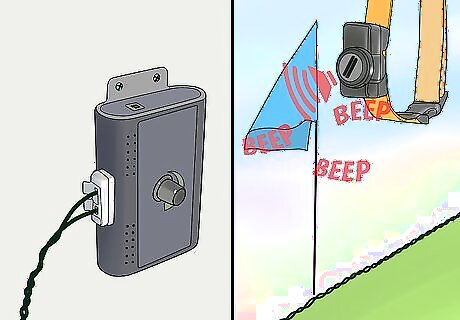
Connect the wire to the transmitter and test the system and collar. You don't need to lay the wire underground to test the system. Simply plug in both ends of the wire to the transmitter and turn it on. After attaching the receiver to the collar, walk over the wire in a few different locations — you should hear a "beep" when the collar is close to the boundary. As obvious as it might seem, do not wear the collar to test it, and don't touch the metal to feel a shock. The shock is mild, but uncomfortable - it should make a sound to let you know it is functioning correctly.
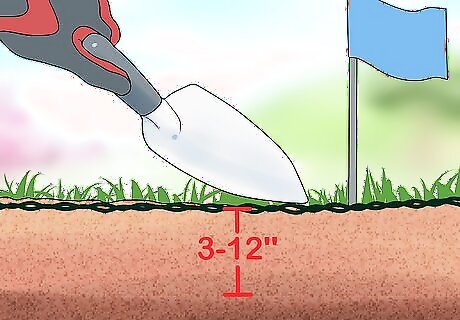
Dig a 3 to 12 in (7.6 to 30.5 cm) deep trench along the marking flags. Using a shovel or gardening trowel, dig just under the surface of the yard to create a thin trench to lay the wire. Don't remove the flags, as they can be helpful in teaching your dog where the boundaries of the yard are. Don't dig too deep, or the transmitter will have a hard time receiving signals from the wire when your dog goes over the boundary. You can lay the wire on top of the grass and it will have the same effect, but to prevent tripping over the wire or accidentally cutting it with a mower, it's recommended to have it placed just under the surface.
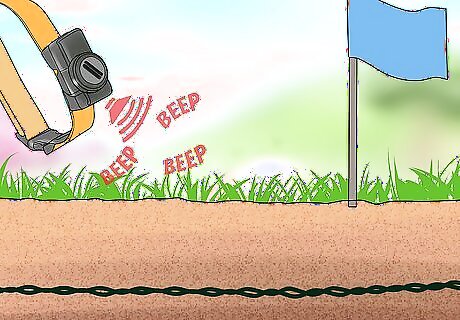
Place the wire underground, cover it with dirt, and test it again. Go around the garden making sure to cover the wire completely with the dirt you excavated earlier. Don't leave any wire above ground or you may risk tripping over it or accidentally severing it when mowing the lawn. Test the system again in multiple places to ensure its effectiveness, and get ready to train your dog. If you decide not to bury the wire, try to keep it out of sight and tucked as close to the earth as possible.
Training Your Dog
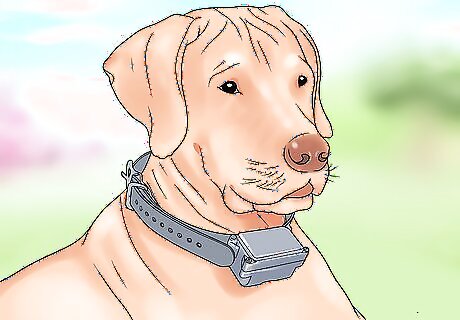
Attach the receiver to the shock collar and let your dog get used to it. The receiver and shock collar can be relatively heavy for some dogs, so be sure to get one that comfortably fits them. The goal is not to hurt your dog, just to nudge them in the right direction through warnings and mild shocks. It should be comfortable wearing the collar before you begin training. If your dog does not seem to respond to the shock collar, consider buying a stronger shock collar or one that has an adjustable strength setting. If your dog continues to ignore the shocks, consider buying a collar that sprays citronella when they cross the boundary instead. This is just as humane as a shock collar, and will work more effectively on large dogs.
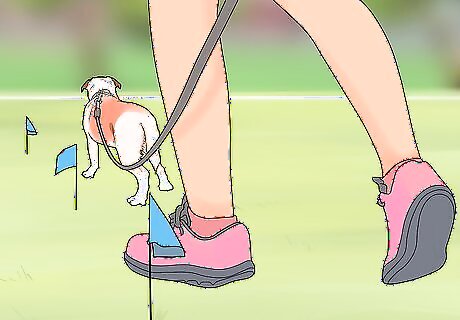
Take your dog to the boundary every hour on a tight leash. Take your dog to a few different points in the yard to show them the full area it is free to roam in. Keep your dog inside or on a short leash outdoors when you are not training it. It will usually take two days or more of continuous hourly training for the dog to understand where the invisible barrier lies. Don't let them go across the boundary even once, or you will have to start from the beginning again.
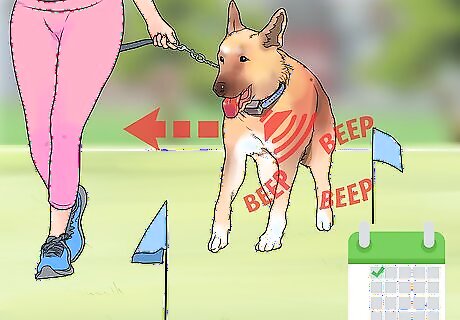
Pull the leash sharply when the shock collar beeps on the first day. When your dog approaches the wire boundary, don't let it go any further and pull it back to you. This will teach your dog where the limit of the yard is and to turn back when it hears a beep. By keeping your marking flags in the ground, you will help your dog to recognize the boundary through visual reinforcement rather than through sound and shock alone. Don't remove the flags until a few days after you are done with training to reinforce your dog's sense of its limits.
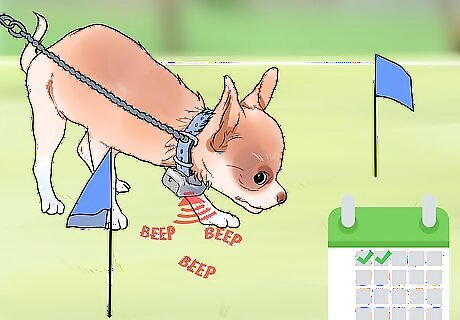
Allow your dog to figure out the boundary on the second day. Using the same process as the first day, take your dog out to different points of the underground fence every hour on a tight leash. Instead of pulling its leash back sharply, let your dog figure out where the invisible barrier is on its own - the shock collar will beep and let off a mild shock when your dog gets too close. If they cross the line, pull it back quickly, but your dog should figure out how to avoid getting shocked on their own.
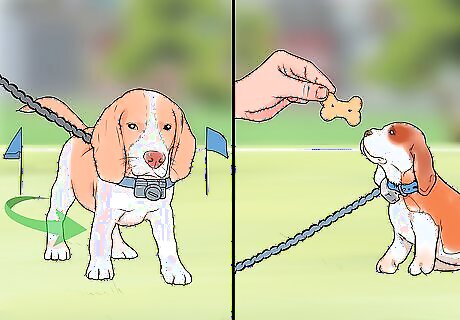
Reward your dog each time it avoids the boundary. At first, you can reward your dog after pulling it sharply away from the underground fence. On the second day, reward it when they successfully stay away from the boundary on their own. If your dog knows basic commands such as "sit", command it to sit at the edge of the boundary to further reinforce its understanding. Be sure to give your dog treats and plenty of praise for following your directions.
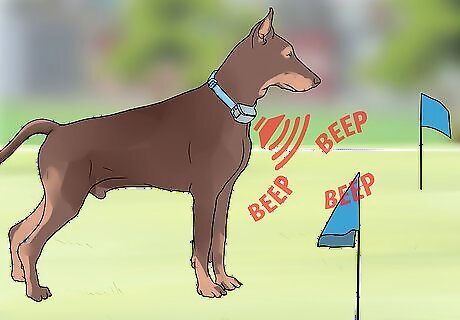
Let your dog loose without a leash after you feel it knows its boundary. After a few days of training, your dog should understand where the boundary is. Let your dog loose, but make sure to keep an eye on it to ensure it stays within the underground fence's limits. If your dog still doesn't to seem to know where the boundary is, you may need to repeat the training each day it understands the limit. Alternatively, if your dog doesn't react to the shock collar, consider turning up the strength of the collar or purchase a citronella spray collar. Be sure to keep an eye on the batteries for your transmitter and shock collar. Most manufacturers recommend changing the batteries every 3 to 6 months.




















Comments
0 comment